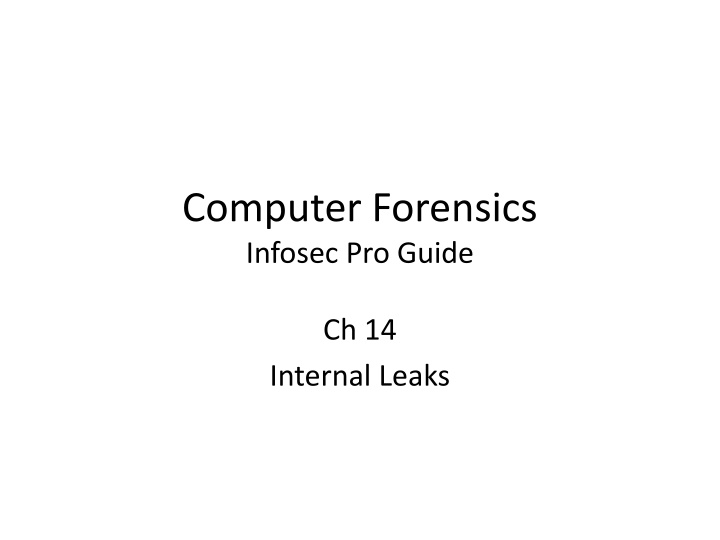
Investigating Internal Leaks: Techniques and Countermeasures
Learn why internal leaks happen, how to investigate and prevent them, types of leaks like corporate espionage and theft, insider threat countermeasures, and the importance of preserving digital evidence in computer forensics.
Download Presentation

Please find below an Image/Link to download the presentation.
The content on the website is provided AS IS for your information and personal use only. It may not be sold, licensed, or shared on other websites without obtaining consent from the author. If you encounter any issues during the download, it is possible that the publisher has removed the file from their server.
You are allowed to download the files provided on this website for personal or commercial use, subject to the condition that they are used lawfully. All files are the property of their respective owners.
The content on the website is provided AS IS for your information and personal use only. It may not be sold, licensed, or shared on other websites without obtaining consent from the author.
E N D
Presentation Transcript
Computer Forensics Infosec Pro Guide Ch 14 Internal Leaks
Topics Why internal leaks happen How to investigate internal leaks File system metadata
Insider Threat Insiders have easy access to critical data Protections are focused on outside intruders
Types of Internal Leaks Corporate espionage Intellectual property theft Stolen business processes Stolen pricing schedules, vendor agreements, and customer relationship management (CRM) data Finance and accounting information to guide stock investments in public companies
Types of Internal Leaks Disgruntled employees may steal information as revenge Poor information security practices can lead to theft Should use strong group policy settings, digital rights management, Active Directory (AD) auditing, and Internet usage tracking Negligence or incompetence leading to theft Laptops can be stolen from cars, etc.
Insider Threat Countermeasures Insiders dare to steal because They see poor security practices and limited internal reviews and audits Security review and auditing of business practices Using a competent outside consultancy Let people know you have tools, training, and processes in place to track what they have done
Preserve Evidence Forensic artifacts are time-sensitive Because normal computer use will overwrite data Use proper forensic methods to acquire and preserve evidence promptly Hard drive, external devices, file server Cell phone, email, tape backups, etc. Best if suspect does not know you are gathering evidence So they can t hide or destroy evidence
Avoid Risky Shortcuts Don't examine a suspect's PC to look for smoking guns before taking a forensic image Such actions could destroy the data you are looking for Copying files changes their timestamps And overwrites latent data
Court Order If a judge has issued a protective order to preserve a computer Your snooping around, even merely booting up the machine, violates that order Make a forensic image and work with the copy
Metadata Data about the data Creation, modification, and access times Some applications also record Author's name Name of computer that created the file Which printer the file was sent to Who the file was emailed to Original filename
Looking for Files Copied to External Media 1. Review registry files User activity in UserAssist and RecentDocs in NTUSER.DAT USBStor in SYSTEM shows use of external storage devices 2. File activity in LNK files 3. Obtain and examine any involved external storage devices
Registry Files Review each user's NTUSER.DAT Compare creation date of NTUSER.DAT With creation dates of \Windows, \Users, and \Program Files Determines the age of the system and user profiles
Important Registry Files For Windows Vista and Win 7 C:\Users\username\NTUSER.DAT For Windows XP C:\Documents and Settings\username\NTUSER.DAT C:\Windows\System32\Config\SYSTEM C:\Windows\System32\Config\SOFTWARE
CCleaner Free tool Often used to empty these registry keys Link Ch 14a
Important Registry Locations NTUSER.DAT\Software\Microsoft\Internet Explorer\TypedURLs NTUSER.DAT\Software\Microsoft\Windows\C urrentVersion\Explorer\UserAssist NTUSER.DAT\Software\Microsoft\Windows\C urrentVersion\Explorer\RecentDocs Also referenced starting with HKCU How they appear in RegEdit
Important Registry Locations SYSTEM\CurrentControlSet\Enum\USBSTOR Also referenced starting with HKLM How it appears in RegEdit
Error in Textbook The UserAssist key is in HKCU, not HKLM as stated at location 4291.
Restore Points Windows makes automatic backups called Shadow Copies Shadow Explorer will let you examine them Very useful; contain copies of files and the Registry before they were deleted Link Ch 14b
Special File Types These filetypes all may contain metadata, such as last time they were printed CAD drawings Microsoft Office files PDF files EXIF Images (many JPEGs)
Microsoft Office Metadata Some examples of metadata that may be stored in your documents Your name Your initials Your company or organization name The name of your computer The name of the network server or hard disk where you saved the document Other file properties and summary information Non-visible portions of embedded OLE objects The names of previous document authors Document revisions Document versions Template information Hidden text or cells Personalized views Comments (from link Ch 14c)
